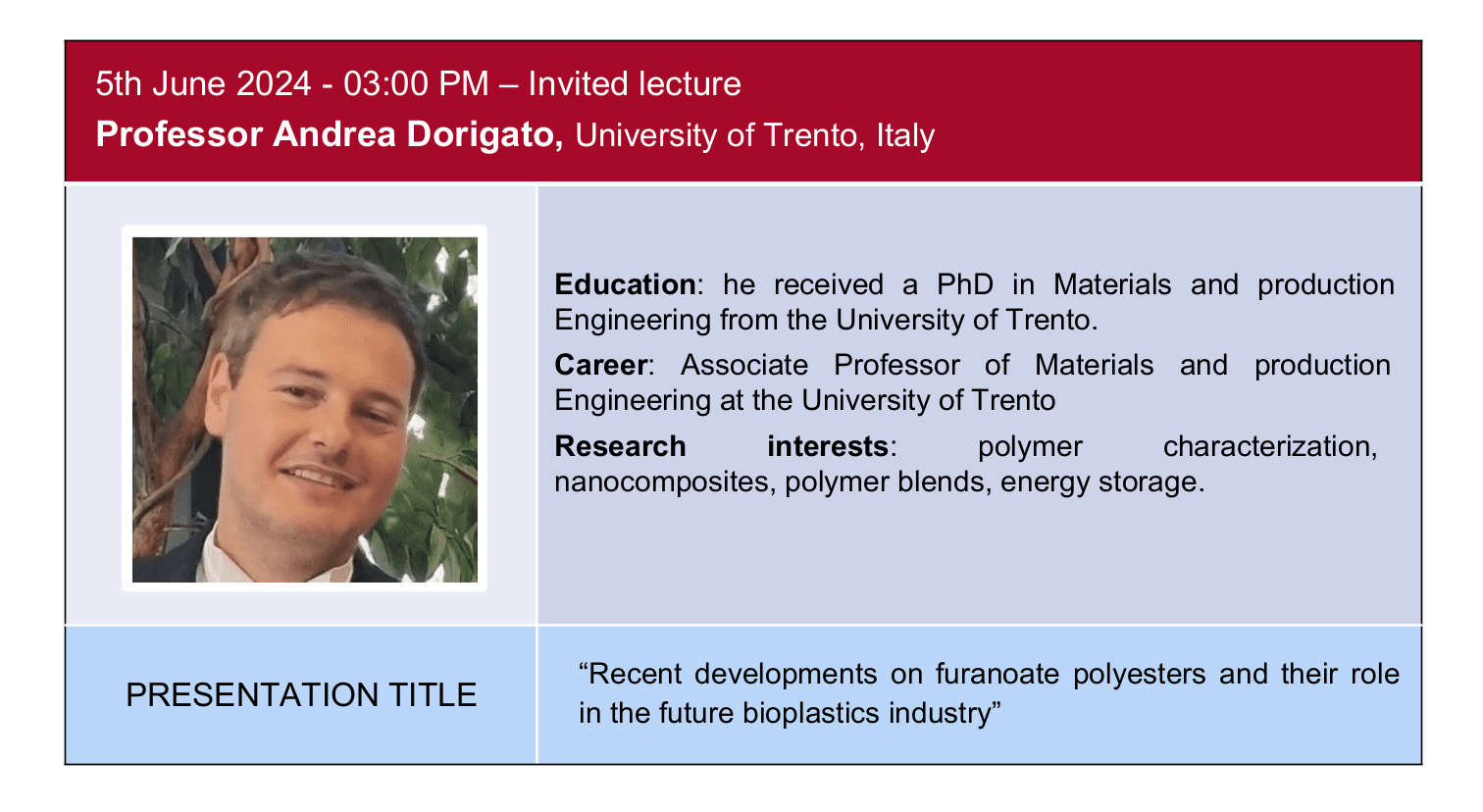Recent developments on furanoate polyesters and their role in the future bioplastics industry
Andrea Dorigato, Giulia Fredi, Daniele Rigotti, Davide Perin, Michelina Soccio, Nadia Lotti, Dimitrios N. Bikiaris, Alessandro Pegoretti

One of the most attractive bioderived monomers for novel bioplastics is furandicarboxylic acid (FDCA), obtainable from the fermentation and dehydration of biomass and listed among the twelve strategic building blocks derived from renewable raw materials [1]. Among the wide variety of polymers derivable from FDCA, furan-based polyesters or poly(alkylene furanoate)s (PAFs) are among the most important ones. Obtained through the polycondensation of FDCA with alkylene glycols, PAFs have already demonstrated comparable or superior thermo-mechanical and gas barrier properties than those of the corresponding poly(alkylene terephthalate)s (PATs), which make them suitable for packaging applications. Polyethylene furanoate (PEF), which has gained great attention, is referred to as the biobased polyester of the future not only for its physical-mechanical properties but also due to the significantly lower energy use and CO 2 emissions compared to polyethylene terephtalate (PET) [2]. Moreover, a series of furan based polyesters, differing for the number of methylene groups of the glycol moiety, can allow the attainment of tunable thermal, mechanical and gas-barrier properties, enabling thus their use in rigid or flexible packaging. This work gives an overview about the recent advancements obtained by our research group on the use of PAFs in modern plastic technology. Different kinds of PAFs differing for the alkyl chain length have been synthesized and utilized for the preparation of films, fibers and electrospun mats [3]. In this work, the attention has been focused on the physical behaviour of multifunctional PAFs based films, to be mainly utilized in the packaging industry. PAFs have been mixed at different concentrations with polylactic acid (PLA), in order to tackle its intrinsic shortcomings and to tailor its physical properties. Both solution blending and melt compounding technologies have been considered. The characterization of PLA/poly(pentamethylene 2,5-furanoate) (PPeF) thin films highlighted that PPeF strongly improved the UV-shielding properties of PLA, with a decrease in transmittance at 275 nm from 47.3% of neat PLA to 0.77% with only 1 wt % of PPeF, while the transmittance decrease in the visible region was marginal, allowing thus the production of optically transparent films. Incorporating PPeF in PLA induced major ductility enhancements, accompanied by progressive stiffness and strength declines. Moreover, PPeF contributed to increase the UV- and gas barrier properties of PLA. Compost burial tests also revealed 26% weight loss of PPeF after 60 days, proving its biodegradability. In some cases, different kinds of nanofillers have been introduced to develop multifunctional bioderived nanocomposites. In order to improve the compatibility between PLA and PAFs, different compatibilizers have been also evaluated. The results of these investigations highlighted the positive and sometimes synergistic role of poly(dodecylene furanoate) (PDoF) and reduced graphene oxide (rGO) in tuning the thermo-mechanical and functional properties of PLA, with simultaneous enhancement of ductility, crystallization kinetics, and gas barrier performance. In poly(decylene-2,5-furanoate) (PDeF)/carbon nanotubes (CNTs) nanocomposite films, the long-term mechanical performance was improved upon CNTs addition, as both the elastic and the viscoelastic components of the creep compliance were considerably decreased.
References
- G. Fredi, A. Dorigato, M. Bortolotti, A. Pegoretti, D.N. Bikiaris Polymers 2020, 12, 2459.
- D. Perin, D. Rigotti, G. Fredi, G.Z. Papageorgiou, D.N. Bikiaris, A. Dorigato J. Polym. Environ. 2021, 29, 3948.
- S. Santi, M. Soccio, G. Fredi, N. Lotti, A. Dorigato Polymer 2023, 279, 126021.
Acknowledgments
This research activity has been funded by CARITRO Foundation within the project BioPackTex (grant number 2020.0265). This work has been partly based upon work from COST Action FUR4Sustain (CA18220).